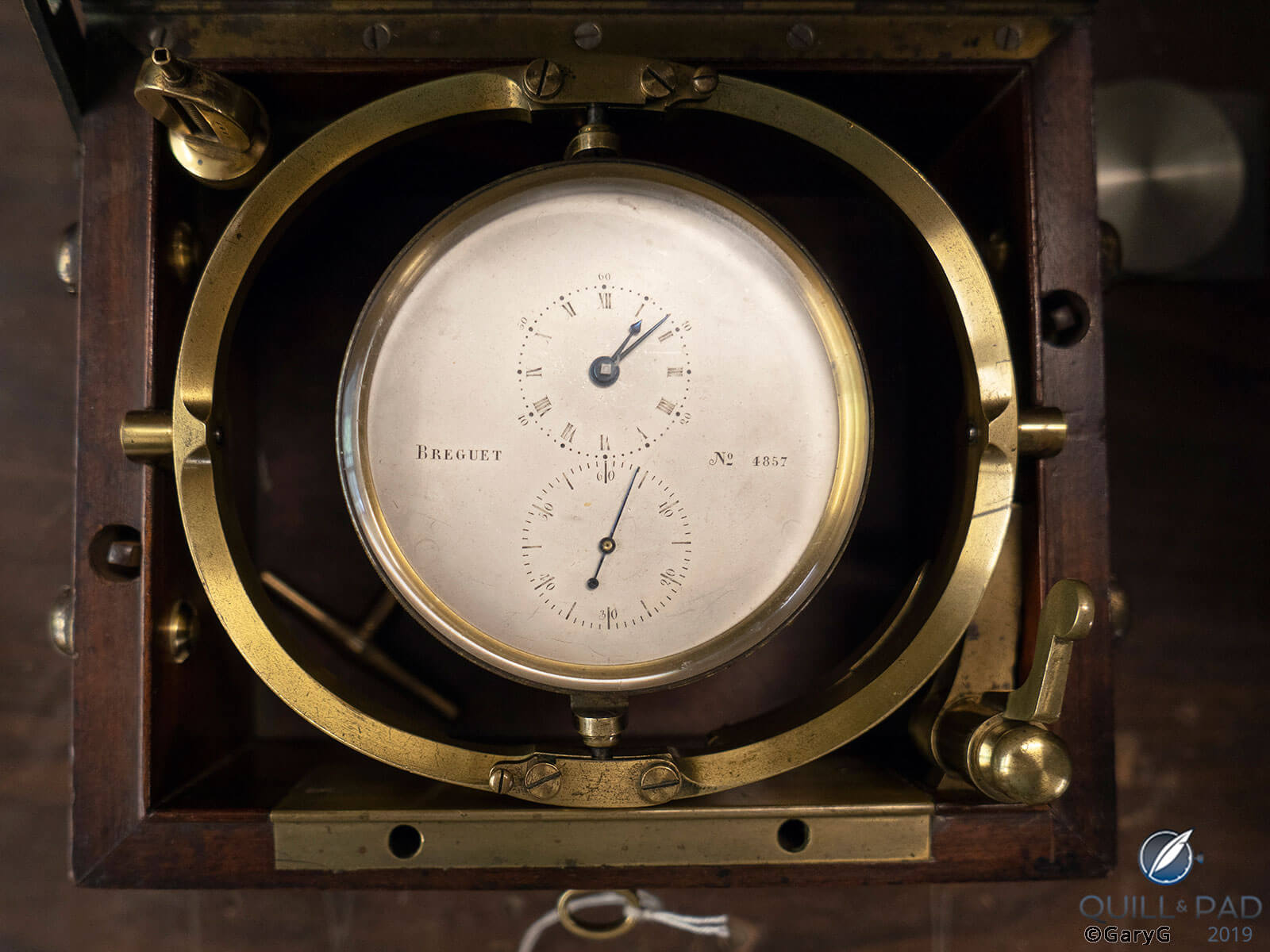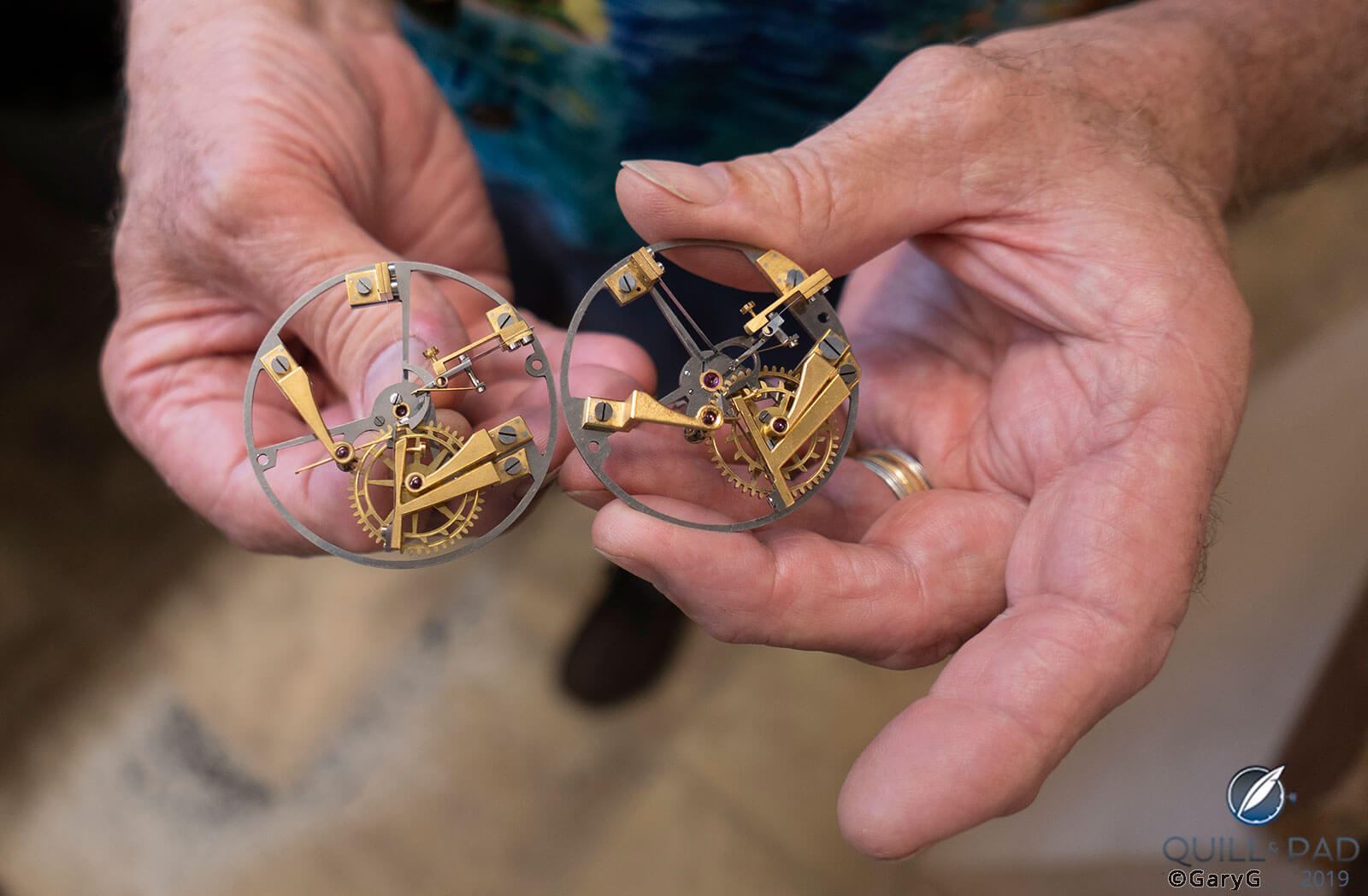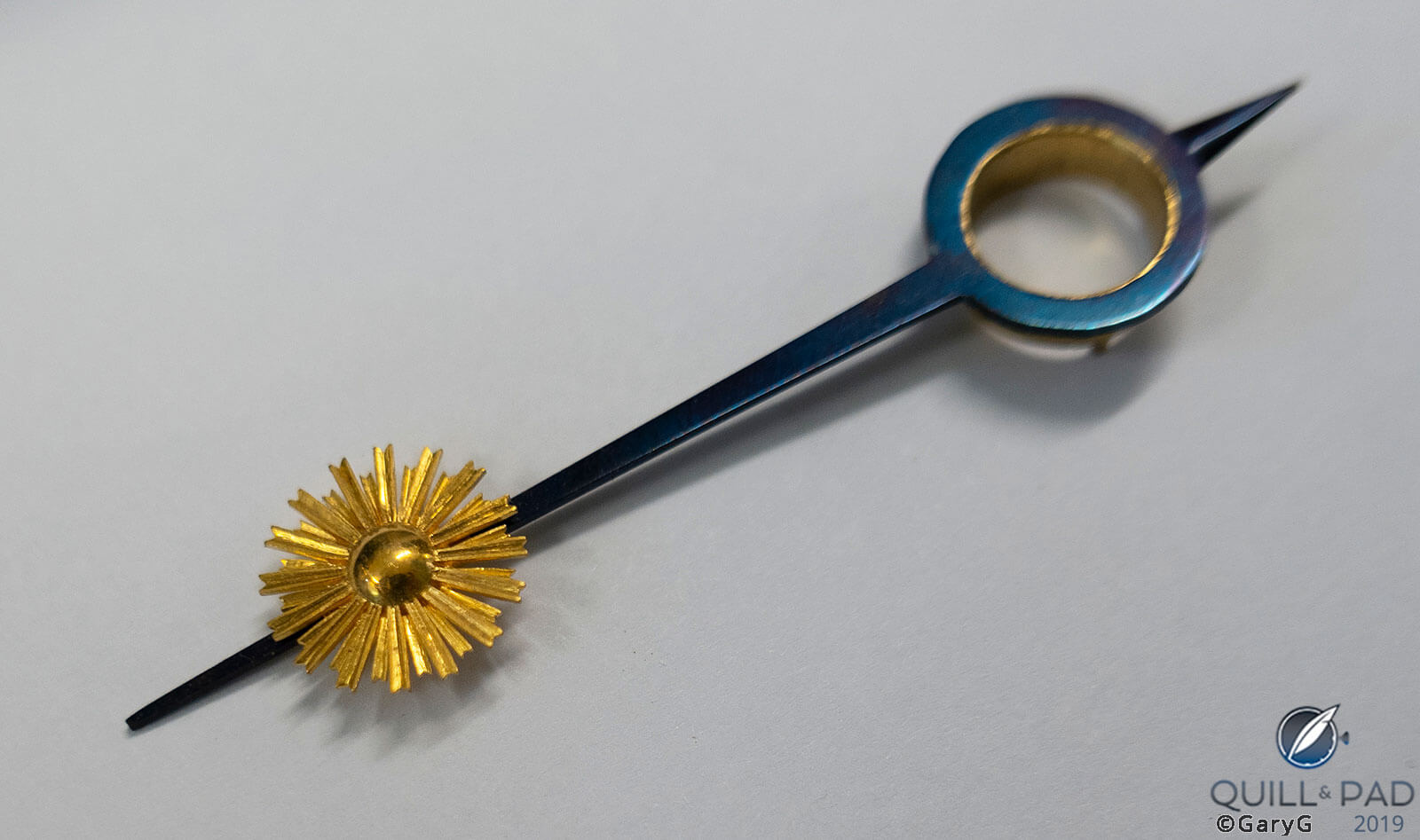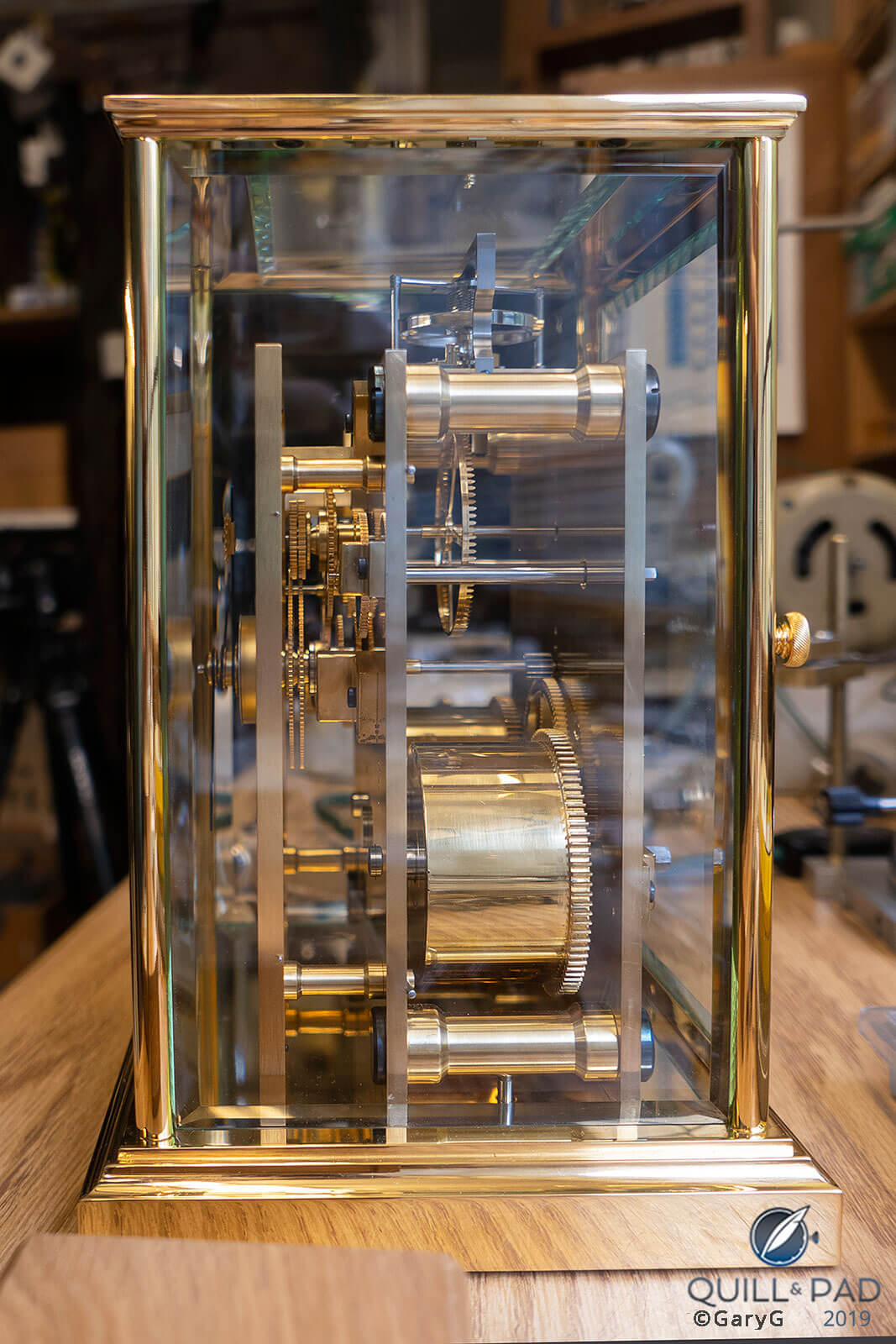Discovering The Secret Of Life With David Walter: Watches, Clocks, And DeeDee’s Tourbillon
by GaryG
One of the great treats associated with being a watch enthusiast is the occasional opportunity to visit with one of the creators of the timepieces we all love so much, whether that’s as part of a watch show, major brand factory tour, or visit to an independent workshop.
For me, one of the only downers of these experiences is that as a Californian I’m usually fighting a deep case of jet lag in a time zone far from my own. I’ve often wished that more of the notable personalities in timepiece development were closer to my home.

Nearing completion: The White by David Walter (image courtesy David Walter)
Happily, one of the top figures in independent clock- and watchmaking is (relatively speaking, at least) right in my backyard, near Santa Barbara, California.
I’d long wanted to meet and learn from David Walter, and through a friend’s introduction I recently had the opportunity to spend the better part of a day with him, discovering his recent watchmaking exploits, soaking in a tiny fraction of his deep knowledge of clockmaking, and encountering one of the most interesting timepieces I’ve seen in quite a while: DeeDee’s Tourbillon.
Getting to know David Walter

In his element: independent horologist David Walter in his workshop
I’d read a great deal about Walter over the years and seen photographs of many of his astonishing clock creations, including the (D)W5, a dual-pendulum clock so accurate and sensitive that during its proving-out period in Walter’s workshop at one point its rate tracings visibly picked up the tremors from a distant earthquake before settling back down into flat-line stability.
As we talked I was a bit surprised to learn that as a young man his original intent was to make watches and that he had journeyed to Switzerland to amass the needed tools and equipment. But he had such difficulty as a foreigner gaining access to what he needed to execute watch-sized micro mechanics he changed his focus and took up what he could: clockmaking.
I for one am grateful that he did, but in more recent years he has returned to his original goals and is now making watches such as The White, based on an Omega Caliber 266 ébauche that he has extensively reworked with reshaped bridges and hand-finished bevels and angles.

Work in process: David Walter’s The White movement, based on Omega Caliber 266
As a result of the path he’s taken, Walter’s workshop is a fascinating treasure trove of timepieces and records. You can imagine how excited I was to see a rare Breguet marine chronometer made during the lifetime of the master himself and serviced and restored in period-correct fashion by Walter.

The master’s work: rare Breguet marine chronometer
The topper was the chance to hold the movement itself in my gloved hands before gently placing it on the table for some photos; for a timepiece lover it doesn’t get a lot better than that!

Breguet marine chronometer movement serviced by David Walter
A more recent historical memento was a 1998 handwritten letter from George Daniels, commending Walter on the quality of his work and inviting him to adapt the co-axial escapement for his own “personal interests.”

A letter from George Daniels and a more recent David Walter movement design
And from the safe emerged some clock-related developments, including a pair of intricate constant-force escapements.

Constant-force clock escapements made by David Walter
Back to the present
We finally worked our way to the present day, starting with an example of the Presidio, a steel-encased watch with engine-turned silver dial made by fellow Californian craftsman Joshua Shapiro.

Presidio by David Walter
While the Presidio is also ébauche-based (using a Soprod A10), Walter continues to build his capabilities for in-house movement development. The next evolutionary step in the process was the development of in-house bridges and plates to house an existing gear train, leading to an in-process project designated Azur, L’Heure Bleue: a bespoke pocket watch that incorporates an American-made Hamilton 992 train and that when completed will be labeled “U.S. Made.”

David Walter Azur movement with ‘Walter Truss’
Civil engineers might recognize the shape of the barrel bridge on this movement as being similar to that of a particular type of railway bridge. Walter shared a bit of lore with me: legendary watchmaker Derek Pratt sometimes incorporated the shape of a construction truss known as a “Pratt Truss” in his designs, and the shape of the bridge in the Azur movement is called a “Walter Truss.”
The current step in Walter’s watchmaking journey utilizes another modified gear train, this time from Omega’s Caliber 269, and once again with a twist: this is the first watch movement whose plates and bridges are made entirely in platinum. As you can imagine, this lends a delightful heft to the weight of the piece – and also creates substantial machining and finishing headaches due to the material’s physical properties.

Platinum movement, David Walter Platinum watch (work in progress)
In addition to its weight, though, the use of platinum confers other advantages. For example, take a look in the photos above and below at the signature and movement number: from some angles they appear quite clearly and from others they are barely visible.
The technique used is both simple and radical: the markings are engraved into the platinum and then filled with molten gold before the surface is polished flat. This is possible due to the significant difference between the melting points of platinum and gold (1,788 degrees Celsius for 900 platinum vs. 927 for 18-karat yellow gold), and the result is both stealthy and pleasing.

David Walter platinum movement with gold brand and serial markings
David Walter: DeeDee’s Tourbillon
After all this, it was time to turn our attention back to clocks and to Walter’s current project for a special client.
I was somewhat surprised as Walter asked me to pull up a chair in front of his workbench as he propped up his computer screen and fired up Skype to connect us with Peter, a noted physician and timepiece enthusiast.
I was deeply impressed to hear Peter describe his collection of notable clocks, but what blew me away was his statement that after several years of corresponding with Walter, he had become an apprentice to him and that he was both amassing all of the needed equipment for hand-making clocks and already making components under Walter’s watchful eye.
He also mentioned that his wife shares his enthusiasm for clocks to the extent that she keeps three marine chronometers in her office, which he’s responsible for winding and setting so that they continue ticking away and keeping good time.
For their upcoming fortieth wedding anniversary, Peter thought long and hard about what gift might be appropriate, and (perhaps not surprisingly to us timekeeping enthusiasts) fell upon the idea of a special clock created to her preferences and with Walter’s input: DeeDee’s Tourbillon.
Officially it’s called the Exhibition Tourbillon No. 1, but as Walter and Peter (and DeeDee) call it by its unofficial name I’m certainly pleased to go along!

DeeDee’s Tourbillon by David Walter
At first glance, this looks like a relatively simple mantel clock, but it’s far more than that. Let’s start on the dial side with the wandering moon complication, first developed by Antide Janvier in about 1785 and applied by him in three clocks.

Dial detail of DeeDee’s Tourbillon featuring the wandering moon complication
In the image above, the wandering moon display consists of the sun hand, two hands for the moon (the platinum moon itself and its accompanying shadow), and the central disk showing the (approximately) 29.5-day lunar cycle.
If you’re thinking that it reminds you of Vianney Halter’s Classic Janvier, you’re halfway correct; while that watch had a similar “shadow moon,” its sun hand was for a marchante equation of time, which runs alongside the time-telling hands. On DeeDee’s clock, the sun hand always represents the position of the sun relative to the moon over the lunar cycle.
Every 24 hours, the entire lunar display (three hands and central disk) rotates through a 360-degree cycle, and continuously throughout the day the positions of the moon, shadow disk, and sun hand move very gradually in relative terms to position the “light” from the sun to illuminate the portion of the moon that is not behind the shadow disk.
At new moon all three hands align, mirroring what happens in reality when the sun is behind the moon as seen from the earth, and the entire moon is in darkness from our perspective.

Sun hand, David Walter Exhibition Tourbillon No. 1 (DeeDee’s Tourbillon)
Over the next 14-plus days, the shadow creeps slowly leftward relative to the underlying moon disk, and the sun moves away from the moon until sun and moon are directly across the dial from each other and the shiny surface of the moon is fully visible – just as in the skies.
But now there’s a challenge for the clock designer: in the northern hemisphere over the first half of the lunar cycle the moon gradually illuminates from right to left, and over the second half of the cycle it gradually darkens – again from right to left.
But on the clock, the shadow disk is all the way to the left of the moon at the full moon, and the simple thing would be to have it creep from left to right over the remainder of the cycle, darkening the moon beginning on the left side.
But that would be wrong!
After considerable thought, and without access to the inner workings of Janvier’s original clocks, Walter identified an extremely elegant way of snapping the “shadow” instantaneously from the left side of the moon to the right at the moment of the full moon, enabling the darkening to take place from right to left and DeeDee’s clock to be astronomically correct.

Simplicity and mechanical elegance: DeeDee’s Tourbillon by David Walter, side view
With all that going on in front of the dial, it’s also good to take a moment to appreciate the dial plate itself, which is also engine-turned by the Presidio’s dial maker, Joshua Shapiro.
Then there’s the regulating organ of this remarkable clock, a tourbillon based on a Peto cross-detent escapement. That’s a mouthful, but for laypeople like myself the simplest explanation as offered by Peter is that in contrast to the Earnshaw design, in which the impulse device and passing spring are on the same side of the escapement, in the Peto design (which was created to overcome the Earnshaw patent) the impulse and passing spring are opposed to each other at a 180-degree angle.

Peto cross-detent tourbillon regulator, Exhibition Tourbillon No. 1 by David Walter
While the Peto design has advantages in terms of rate stability, it is devilishly difficult to perfect; as a result, very few timepieces have been made using it (perhaps six prior to 1900; two in the 1900s, including George Daniels’ Pocket Watch No. 3; and the current piece).
Neither Walter nor Peter are aware of any other use of the Peto cross-detent in a tourbillon.
An heirloom with personal touches
Peter and DeeDee’s intent with the Exhibition Tourbillon No. 1 is to create an important horological work that will be treasured long after they are gone. At the same time, it’s a highly personal item that commemorates a loving life spent together as reflected in several design choices made by DeeDee as well as both hidden and visible inscriptions that I won’t reveal.
There is, however, one particularly lovely thought I can mention that will stay with this clock wherever it goes forever and always: the couple’s favorite James Taylor lyric, engraved on the back plate of the movement: “The secret of life is enjoying the passage of time. ”

Parting shot: the secret of life . . .
For more information, please visit www.davidwalter.com.
Quick Facts David Walter Exhibition Tourbillon No. 1 (DeeDee’s Tourbillon)
Case: gilded brass frame with 5 mm beveled glass panels
Dial and hands: engine-turned silver dial by Joshua Shapiro with multiple guilloche patterns; blued hands with hand-carved gold sun medallion and platinum moon
Movement: exhibition caliber by David Walter with Peto cross-detent tourbillon escapement, spiral hairspring, and lunar display mechanism; twin mainspring barrels with eight days’ worth of power reserve
Functions: hours, minutes; wandering moon display with relative positions of sun and moon; shadow moon phase display with instant flyback at full moon; days remaining until new moon indicated by pointer on central disk
Price: not disclosed
Production year: 2019
You may also enjoy:
The Life And Times Of Legendary Independent Watchmaker Derek Pratt
Paul Gerber: Renaissance Man And Creator Of World’s Most Complicated Watch And Smallest Wooden Clock
Karel Rotation By Independent Czech Watchmaker Ludek Seryn: Symmetry In Perfect Harmony
Leave a Reply
Want to join the discussion?Feel free to contribute!



Great write up Gary! As always your photos do David’s work a great service by revealing his horological wizadry to those that don’t get see or handle his work. That clock is quite something, I had the good fortune to see it a couple of months ago. Thank you for shining the light on an important fellow in the Independent Watch & Clockmaking world.
Thanks for commenting, Tim, and for all of your support of the indies over these many years!
Best, Gary
Dear David,
Great work! I love your style and that you do a lot of work with detent escapement. Peto cross is a good choice for your incredible watches.
Thanks Gary for the article.
Thomas Prescher
The website is being updated
Great to hear from you, Thomas — and it’s wonderful to see the support that the independents show for each others’ work.
Best, Gary
Thank both Gary for writing an excellent article and superb photography and Thomas for the kind compliments
David